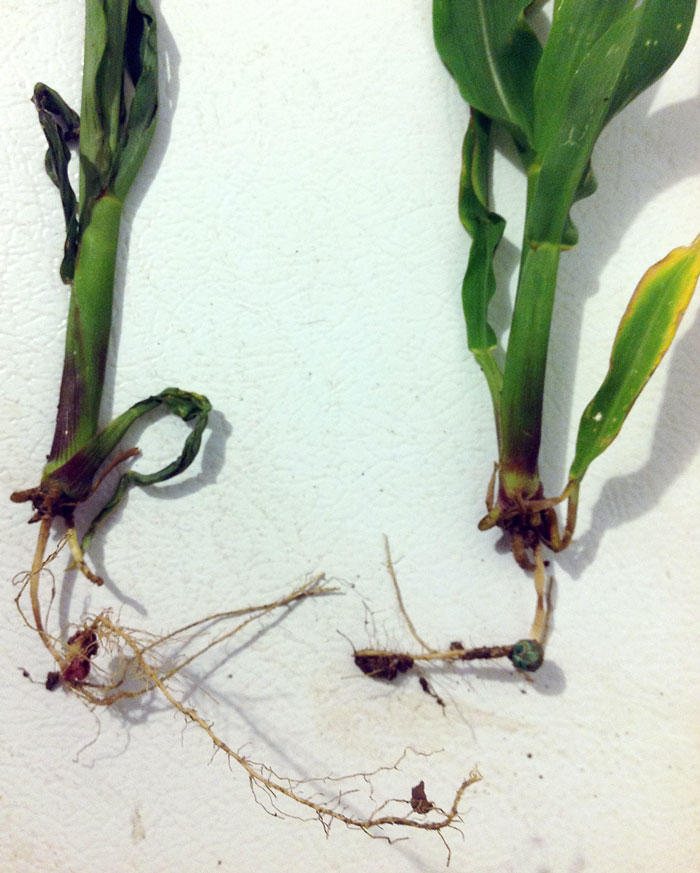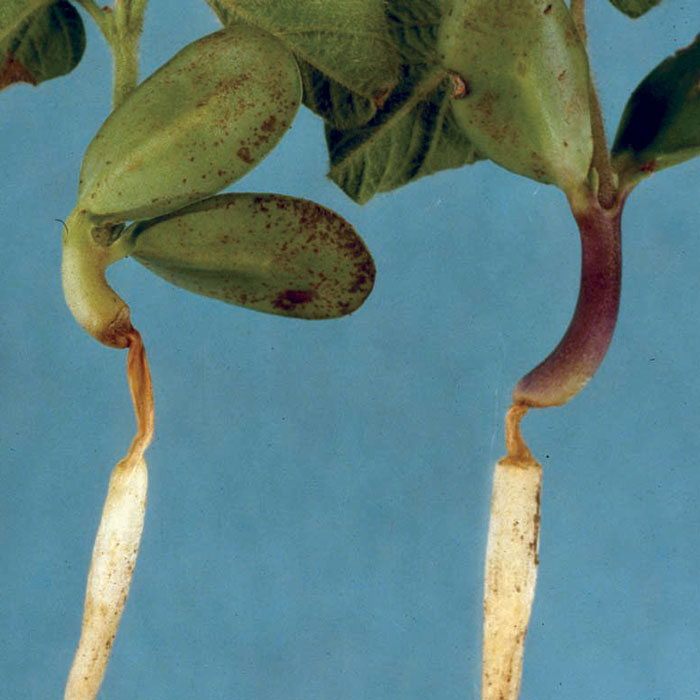Taking an environmentally sensitive approach to pest management
Two Specific Concerns about Drought/Heat Effects on Soybean and Corn Seedlings
Published: May 31, 2018
A few parts of Missouri have nearly water-saturated soil conditions, but much of the Missouri grain crop growing area is experiencing dry soils and hot temperatures. The United States Drought Monitor may be underestimating the effect of the unusual combination of sparse precipitation and hot temperatures. Conditions can change rapidly and may be variable even within a field because the interaction between soil physical characteristics and plant water availability. Our experiences with and knowledge about early season water stress are limited. This report presents information about two unusual conditions that result from drought/heat effects on seedlings and young plants.
Rootless Corn Syndrome
Corn plants produce two root systems. The first root system consists of roots that emerge from the seed and nourish the seedling. The second root system consists of adventitious (nodal) roots that form at stem nodes below and above the soil surface. This is the main root system of the corn plant. Plant health and yield is closely tied to the health and function of these roots. Nodal roots are present as early as the 1-leaf stage and rapidly expand in number and length during vegetative growth. The earliest nodal roots form about ¾ inch below the soil surface.
Figure 1 Rootless corn syndrome. Note lack of development of nodal roots. Source: UM Extension
All roots require soil moisture to form and grow. Because corn nodal roots form near the soil surface they are highly dependent on soil moisture near the surface. In most years, spring precipitation keeps the soil wet enough for roots to grow. But, early season drought can dry soil to a point where roots cannot grow. This is compounded by hot soil surface temperatures. Root growth is inhibited and even prevented by hot, dry soil.
A syndrome called rootless corn may occur (Figure 1). Affected seedlings have normal primary roots, those roots that developed from the kernel. But, they lack adventitious roots. These plants may appear normal, but begin to lodge when plants are about 15 inches tall because they are weakly anchored. Most Missouri corn is well past any concern. But, late planted corn, including fields that were replanted, may be vulnerable to rootless corn syndrome if the soil surface is unusually dry. Preventive actions are few. If replanting corn, try not to till. Tillage wastes precious water. Previous crop residue that remains on the soil surface reduces water evaporation and slows the rise in soil temperature.
Heat Canker in Soybean
This is an unusual occurrence in soybean related to soil surface temperature. Because evaporating water cools soil, the condition usually occurs when precipitation is sparse and the soil surface is extremely dry. The Missouri network of weather stations has recently reported soil temperatures above 95°F at the 2-inch level under bare soil. Soil surface temperature are usually much warmer. Early in the growing season plants are small and sunlight impinges on the soil surface. Soil absorbs the light and gains in temperature. With sparse leaf area, hot air temperatures, and bright sunshine, it is not uncommon for surface temperatures to exceed 120°F.

Figure 2 Heat canker. Note dead cells where hypocotyl touched soil surface. Source: American Soybean Association
Soybean seedlings that are just emerging and up to V2 are vulnerable to heat canker. Young hypocotyl cells (region below the cotyledons) where the hypocotyl touches the soil surface cannot tolerate hot temperatures and die (Figure 2). This can occur as a ring around the stem or just on one side. The region appears "pinched" because water has escaped and the cells have shrunk. The region will quickly darken. Affected plants often die. With heat canker, the root system remains white and looks normal. This can be used to distinguish between a seedling disease in which roots are discolored and this environment caused condition.
This is a rare occurrence, but this is a year with rare combinations of sparse precipitation and hot temperatures. When heat canker is suspected, often only a few seedlings are affected. Very localized conditions can influence the severity. However, hundreds of thousands of Missouri soybean acres have been planted during dry, hot weather. Heat canker could be more widespread and affect a large portion of seedlings than usual. There is little that can be done once heat canker is visible – the damage has been done. Previous crop residue that remains on the soil surface reduces water evaporation and slows the rise in soil temperature. It is rare to see heat canker in no-tillage fields.
Subscribe to receive similar articles sent directly to your inbox!
REVISED: February 21, 2017